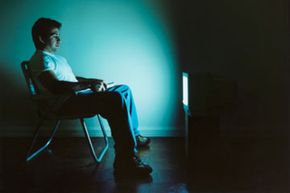Every kid knows the list of warnings from Mom: "If you cross your eyes, they'll get stuck that way." "Gum stays in your tummy for seven years." "Cracking your knuckles causes arthritis." "Too much television is bad for your eyes." Some of these Mom-isms are true; some aren't. And some exist in a murky place in between fact and fiction.
"Watching too much television is bad for your eyes" is one of those murkier examples. The answer isn't all that clear. Most experts agree that staring at the television (and computer monitors) won't cause permanent damage to a person's eyes. However, focusing your eyes too long on any one thing can cause eyestrain, a temporary (but irritating) problem. We'll talk more about eyestrain later in the article.
Advertisement
So, if watching too much television won't actually impair your vision, where did this warning come from? Interestingly enough, at one time, the warning was based in truth. Back in the 1960s, more and more families could afford televisions, and it was a pretty new and exciting technology. Of course, these weren't the flat-screen LCD televisions we enjoy today. Back then, televisions were big, boxy affairs -- full of tubes and wires and bulbs.
Around 1967 or so, General Electric Company (GE) disclosed the fact that many of their color televisions were, due to a factory error, emitting excessive X-rays. Overexposure to X-rays can be dangerous, and Public Health Service officials estimated the radiation from the tube was 10 to 100,000 times the rate considered safe and normal. GE corrected the problem by shielding the tubes inside the television with leaded glass.
At the time, health officials stated the excessive levels of radiation wouldn't harm most viewers. However, they did warn against children sitting close to the television for more than an hour, due to the X-rays shooting through the vents on the bottom of the set. Even though GE recalled and repaired the faulty television sets, the threat of physically damaging X-rays remained in people's thoughts. So, that's one reason why Mom and Dad warn us not to spend too much time watching TV.
Another reason? Children typically sit on the floor to watch television, with their heads tilted up. This causes more eyestrain than sitting eye-level with the television set. Again, eyestrain isn't a permanent problem.
Lastly, parents can mistake the symptom for the cause. Sitting close to the television may not make a child nearsighted, but a child may sit close to the television because he or she is nearsighted and undiagnosed. If your child habitually sits too close to the television for comfort, get his or her eyes tested.
Next, we'll talk about the relationship between technology and eye problems. And later, you'll learn more about eyestrain and how to prevent it. Keep reading (but don't forget to rest your eyes)!
Advertisement



